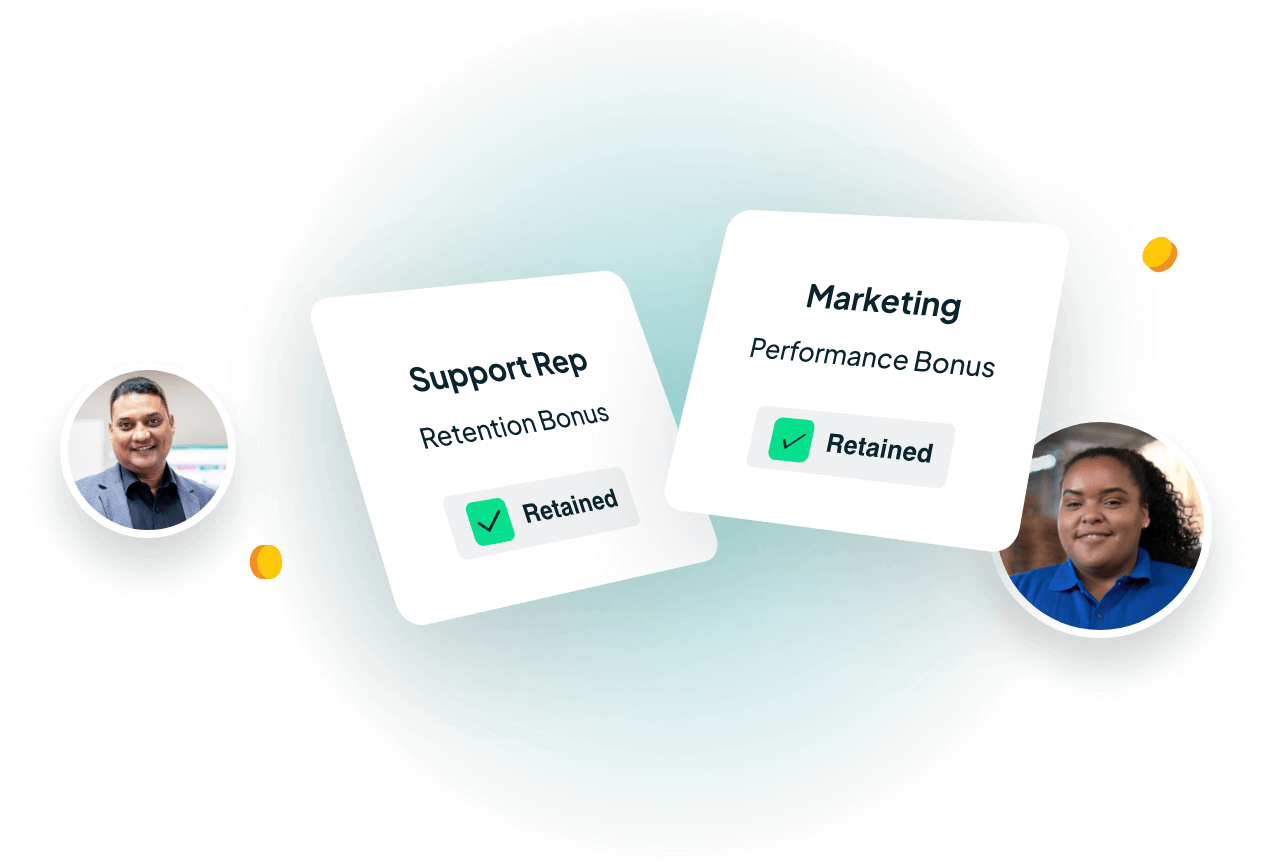-
Why Keep?
Why Keep
-
Employers
-
Employees
-
- Solutions
- Resources
- About Us
Table of Contents
- The Ultimate Guide to Employee Compensation (2023)
- Understand the Importance of Employee Compensation, Benefits & Bonuses
- What is Employee Total Compensation and Benefits? (maybe too simple for HR Leaders - good for SEO - fine to delete)
- Explore Different Types of Employee Compensation & Bonuses
- What Are Some Examples of Compensation?
- How to Figure Employee Compensation? (w/ Formula)
- Consider the Needs and Wants of Employees
- Analyze Job Performance to Determine Which Levels of Compensation are Appropriate
- Research Employee Compensation Policies
- Develop a Comprehensive Plan for Determining and Implementing Employee Compensation
- Employee Compensation Tools & Resources
- Employee Compensation Ideas & Examples
- Keep Your Talent - With Keep Financial
The Ultimate Guide to Employee Compensation
Employee compensation can be a complex yet critical part of running a business. Whether you manage 10, 100, or 1,000 employees, it's essential to stay up-to-date on the latest advice and trends surrounding your employees' wages.
A well-thought-out pay structure should motivate and reward top performers while also being as fair as possible across multiple departments and experience levels. That's why our team has put together The Ultimate Guide to Employee Compensation; created especially for HR and Finance leaders looking for an in-depth overview of the topic.
In this guide, we’ll discuss various aspects that factor into employee compensation such as job descriptions, salary ranges, incentive plans, benefits packages, and more! We hope this guide provides all you need to know about how to create a successful pay structure for your employees so everyone is happy with their financial situation at work.
Understand the Importance of Employee Compensation, Benefits & Bonuses
In today's competitive business world, understanding the importance of employee compensation, benefits, and bonuses is crucial for any company looking to attract and retain top talent. These elements not only reflect an organization's commitment to its workforce but also play a significant role in boosting employee morale, increasing job satisfaction, and fostering productivity.
A well-designed and comprehensive compensation package, inclusive of benefits like health insurance, retirement plans, and generous time-off policies, helps create a positive work environment, where employees feel valued and motivated to perform at their best.
Flexible compensation and bonuses, such as performance incentives or vesting cash bonuses, further emphasize the company's appreciation for individual and team accomplishments, strengthening the employer-employee relationship.
By investing in competitive compensation and benefits packages, businesses can leverage this powerful tool in attracting top talent, ensuring long-term success, and become employers of choice in their respective industries.
What is Employee Total Compensation and Benefits? (and How to Make it Flexible and Valuable for All)
Employee total compensation and benefits refer to the complete package of rewards and benefits that an employee receives in exchange for their work. This includes not only the employee's salary or hourly wage, but also benefits such as health insurance, retirement plans, paid time off, bonuses, and other incentives.
Employee total compensation and benefits are typically outlined in an employment contract or agreement and can be an important factor in attracting and retaining talented employees. Employers may offer different compensation packages depending on the level and type of work performed, the industry, the geographic location, and other factors.
Explore Different Types of Employee Compensation & Bonuses
Delving into the world of employee compensation and bonuses can be fascinating as it not only sheds light on the various ways in which organizations reward their staff but also highlights the growing importance of recognizing and retaining talent.
Traditionally, people tend to think of compensation solely in terms of basic salaries and hourly rates; however, it encompasses so much more. Companies are now devising creative and strategic compensation packages that encompass a wide array of components such as performance-based incentives, profit-sharing plans, stock options, and even innovative bonuses (signing and vesting cash bonuses). These components not only entice highly-skilled professionals to join a company, but they also ensure that their performance is aligned with the organization's goals.
Employee benefits such as health insurance, retirement plans, and paid leave are increasingly becoming a core part of these packages, reflecting a deeper understanding of employee well-being and work-life balance. Having flexible benefits helps employees and your organization hit their financial goals.
Overall, these dynamic and evolving compensation structures are transforming the way businesses acquire, reward, and retain exceptional talent, and are setting new standards in the world of work.
What Are Some Examples of Compensation?
Here are some examples of employee compensation:
- Base salary or hourly wage: This is the fixed amount of money an employee is paid for their work.
- Health insurance: Employers may offer health insurance plans to employees, which may include medical, dental, and vision coverage.
- Retirement plans: Employers may offer retirement plans such as 401(k) or pension plans to help employees save for their future.
- Stock options: Some companies may offer stock options to employees as a form of compensation, allowing them to purchase company shares at a discounted rate.
- Profit-sharing: Employees may receive a share of the company's profits as part of their compensation.
- Vacation and sick time: Employers may offer paid time off for vacations or sick leave.
- Flexible work arrangements: Employers may offer flexible work schedules, remote work options, or other arrangements as a form of compensation.
- Education and training: Employers may offer education and training programs to help employees develop new skills and advance in their careers.
- Employee discounts: Employees may receive discounts on products or services offered by the company as a form of compensation.
- Bonuses: These can be one-time payments made to employees as a reward for their performance or vesting cash bonuses that help them achieve personal financial goals while ensuring retention with the company.
How to Figure Employee Compensation? (w/ Formula)
Calculating employee compensation can be a complex process as it involves various components such as salary, benefits, and incentives. Here are the steps to figure out employee compensation that includes salary, health insurance, retirement plans, stock options, vacation/sick time, and vesting cash bonuses:
- Determine the employee's base salary or an hourly wage. For example, let's say an employee's base salary is $50,000 per year.
- Add the value of any health insurance benefits the employee receives. If the employer pays 100% of the premium for the employee's health insurance, for example, the value of the benefit would be the full cost of the premium. If the premium cost is $5,000 per year, then the total compensation would be $55,000.
- Calculate the value of the retirement plan benefit. If the employer offers a 401(k) plan and matches employee contributions up to 5% of their salary, for example, and the employee contributes $2,500 per year, the employer match would be an additional $2,500. Therefore, the total compensation would be $60,000.
- Determine the value of any stock options the employee may receive. This can be more complex, as the value of the options will depend on the current market value of the company's stock, the strike price of the options, and other factors.
- Add the value of any vacation or sick time the employee receives. If the employee is entitled to 10 days of paid vacation per year and the base salary is $50,000, the value of the benefit would be $1,923.
- Finally, add the value of any vesting cash bonuses. For example, if the employee is eligible for a $5,000 vesting cash bonus, the total compensation would be $66,923.
Formula: Total Compensation = Base Salary + Health Insurance Benefit + Retirement Plan Benefit + Stock Option Value + Vacation/Sick Time Value + Vesting Cash Bonus Value.
Consider the Needs and Wants of Employees
In today's dynamic work environment, it is essential for employers to consider the needs and wants of their employees to foster a positive and productive atmosphere. A strategic approach involves understanding individuals' unique requirements and aligning them with organizational goals, thereby ensuring their professional and personal growth.
By offering flexible working hours, clear communication channels, and opportunities for skill development, employers can demonstrate their commitment to employee satisfaction and well-being. Creating a work culture that values diversity and inclusion, recognizes employee achievements, and prioritizes a healthy work-life balance will not only retain top talent but also helps in building a resilient and innovative workforce.
Flexible compensation is a topic that has been gaining more attention in recent years as companies seek to provide more options to their employees when it comes to total compensation. One element of flexible compensation that is becoming increasingly common is vesting cash bonuses. This option can be attractive to both employers and employees as it allows for greater financial planning and can incentivize employees to stick around for longer periods of time.
A key aspect of meeting the wants and needs of employees is through diversity, equity, and inclusion in the workplace. By prioritizing these aspects, we can create a workplace that is not only welcoming and inclusive but also facilitates growth and success for our employees, leading to a more productive and positive work environment.
Ultimately, addressing employees' needs and wants paves the way for a thriving organization that fosters continuous improvement and success.
Analyze Job Performance to Determine Which Levels of Compensation are Appropriate
In today's highly competitive business environment, it is crucial for companies to accurately analyze job performance to determine appropriate levels of compensation for their employees. This process, which involves assessing an employee's skills, productivity, and overall contribution to the organization, plays a key role in employee satisfaction and retention.
When employees are rewarded based on their job performance, it not only fosters a sense of personal achievement but also conveys a clear message that hard work and dedication are recognized and appreciated. A well-structured compensation system promotes commitment, stimulates motivation, and ensures that employees have a stake in the success of their company.
By leveraging performance metrics and employee feedback, organizations can create a fair and motivating compensation model, ultimately driving their business toward increased growth and profitability.
Research Employee Compensation Policies
Delving into the world of employee compensation policies can be a fascinating and rewarding endeavor. As you conduct your research, you may come across a variety of methods and strategies organizations use to ensure equitable and competitive salaries and benefits for their workforce.
It's critical to understand the factors that impact compensation structures, such as the job market, employee demographics, and industry standards. As you analyze and compare different approaches, you will begin to see the delicate balance businesses must maintain to attract and retain top talent while maintaining financial stability.
Ultimately, becoming well-versed in employee compensation policies is a valuable asset that can inform future decisions, contribute to the success of your own organization, and foster a more engaged and committed workforce.
Develop a Comprehensive Plan for Determining and Implementing Employee Compensation
Embarking on the journey to develop a comprehensive plan for determining and implementing employee compensation can be a game changer for your organization. A well-crafted plan not only helps in attracting and retaining top talent but also fosters a sense of fairness and motivation among employees.
To create such a plan, it's crucial to consider various factors like market trends, internal equity, and company resources. Delve deep into competitive research and industry-specific salary data to set the benchmark and ensure your offerings align with current norms. At the same time, don't forget to factor in skill sets, experience, and education levels to ensure that each employee is fairly compensated.
Lastly, an open and transparent communication strategy is essential in rolling out these compensation packages - this way, employees are well-informed about their expectations, rights, and rewards, ultimately leading to a motivated and satisfied workforce.
Developing a comprehensive plan for determining and implementing employee compensation involves several steps.
Here are the key steps involved in the process:
- Conduct a job analysis: Start by analyzing each job position to determine the roles and responsibilities, required qualifications, experience, and skills. This information will help you determine the appropriate compensation for each job position.
- Research industry standards: Conduct research to determine the typical compensation packages for similar job positions in your industry, geographic location, and company size. This information will help you to determine a competitive and fair compensation package for your employees.
- Define the compensation structure: Define the compensation structure based on the job analysis and industry research. This includes determining the base salary, performance-based incentives, benefits, and other perks.
- Develop a compensation philosophy: Develop a clear and concise philosophy that outlines the company's approach to compensation, such as how it aligns with the company's goals and values.
- Create a budget: Determine the budget for employee compensation, including salaries, bonuses, benefits, and other incentives. The budget should align with the company's financial goals and objectives.
- Communicate the compensation plan: Communicate the compensation plan to all employees, including the salary structure, benefits, and incentives. Ensure that employees understand the value of their compensation package.
- Monitor and evaluate: Monitor and evaluate the effectiveness of the compensation plan. Analyze employee satisfaction levels, retention rates, and performance to ensure that the plan is effective in attracting, retaining, and motivating employees.
- Make adjustments: Make adjustments to the compensation plan as necessary to ensure that it remains competitive, fair, and aligned with the company's goals and values.
Overall, developing a comprehensive plan for determining and implementing employee compensation requires careful analysis, research, and communication. By following these steps, companies can create a compensation plan that is competitive, fair, and aligned with the company's goals and values, which can help to attract, retain, and motivate employees.
Employee Compensation Tools & Resources
In today's competitive business landscape, a well-designed employee compensation strategy is pivotal for attracting and retaining top talent. A thorough understanding of employee compensation tools and resources can make all the difference when it comes to creating a motivated and engaged workforce.
These tools offer insights into industry benchmarks, thereby helping organizations build strategies to offer equitable pay and stay in tune with the ever-changing market trends. Also, they assist in recognizing exceptional employee performances via rewards or incentives, encouraging professional growth and fostering a dynamic work culture.
Implementing these resources allows businesses to maintain a competitive edge and drive long-term success, while simultaneously empowering their workforce to unlock their full potential.
Here are some examples of employee compensation tools and resources:
- PayScale: A platform that provides salary and compensation data for various job positions and industries, which can be used to benchmark employee compensation and ensure it is competitive.
- Glassdoor: A job search and recruiting website that provides information on salaries, benefits, and company reviews to help job seekers make informed decisions. It can also be used by employers to determine competitive compensation packages.
- Salary.com: A platform that provides salary data and compensation management solutions, including job description tools and pay data analysis.
- LinkedIn Salary: A tool on LinkedIn that provides salary data for various job positions and industries, based on user-reported data.
- SHRM (Society for Human Resource Management): A professional association that provides resources and tools for HR professionals, including compensation data and best practices.
- Total Rewards Software: A platform that provides tools for managing employee compensation and benefits, including salary structures, performance-based incentives, and benefits administration.
- Mercer: A consulting firm that provides data-driven insights and solutions for compensation and benefits, including benchmarking, salary surveys, and compensation consulting.
- Keep Financial: A platform that helps improve employee recruitment, retention, and performance through vesting cash bonuses.
Overall, these tools and resources can help employers determine competitive and fair compensation packages for their employees, provide valuable insights into industry trends and best practices, and ultimately deliver valuable compensation to retain top talent.
Employee Compensation Ideas & Examples
Implementing creative and effective employee compensation strategies has become increasingly important for companies seeking to attract and retain top talent.
There are numerous ways that organizations can design compensation packages to incentivize and reward their employees, going beyond traditional monetary bonuses and salary increases. For example, offering flexible work arrangements, such as remote work options or flexible hours, can be a highly-valued perk for those who strive for work-life balance.
Additionally, investing in employee wellness programs, such as gym memberships or mental health support, can demonstrate a company's commitment to the well-being of their staff. Stock options and profit-sharing plans are also excellent ways to emphasize long-term growth and align the interests of employees with the success of the company.
Another powerful compensation approach includes offering educational opportunities, such as tuition reimbursement or professional development courses, helping employees see a clear career path and future within the organization. By exploring these compensation ideas and customizing them to suit the needs and values of their employees, businesses can foster a more engaged, productive, and loyal workforce.
Here are some employee compensation ideas and examples:
- Variable pay: This includes performance-based incentives, bonuses, commissions, profit-sharing, and stock options. This type of compensation can motivate employees to perform better and align their interests with the company's success.
- Health and wellness benefits: This includes health insurance, dental and vision insurance, wellness programs, and flexible spending accounts. These benefits can help attract and retain employees, as well as promote a healthy and productive workforce.
- Retirement plans: This includes 401(k) plans, pension plans, and other retirement benefits. These benefits can help employees plan for their future and provide financial security in retirement.
- Time off benefits: This includes vacation time, sick leave, and personal days. Providing generous time off benefits can help employees maintain work-life balance and reduce burnout.
- Employee perks: This includes gym memberships, free lunches, transportation benefits, and other perks that can make the workplace more enjoyable and attractive.
- Education and training: This includes tuition reimbursement, continuing education programs, and professional development opportunities. Investing in employee education and training can help develop skills and knowledge that benefit both the employee and the company.
- Sabbaticals: This involves providing extended time off for employees to pursue personal or professional interests. This can help employees recharge and return to work with renewed energy and creativity.
- Vesting cash bonuses: A cash bonus that is paid to an employee upfront and earned over time – with vesting acceleration available if performance goals are met.
Overall, providing a comprehensive and attractive compensation package can help attract and retain top talent, promote employee satisfaction and engagement, and support the company's success.
Keep Your Talent - With Keep Financial
In conclusion, employee compensation is critical for businesses to thrive and can yield significant benefits. It is important to understand all of the ways that you can properly compensate your employees, while also considering their needs and wants.
Taking the time to research employee compensation policies and develop a comprehensive plan to determine & implement employee compensation is crucial. Through proper management, understanding different types of compensation & providing bonuses will help create an environment that motivates, engages, and rewards your team.
By aligning the financial interests of employees with those of the company, Keep Financial's vesting cash bonus can create a sense of shared purpose and commitment that helps keep top talent on board.
To learn how Keep Financial can help you deliver valuable, flexible compensation that fits the needs of today’s workforce, schedule a demo today!
Get more insight.




